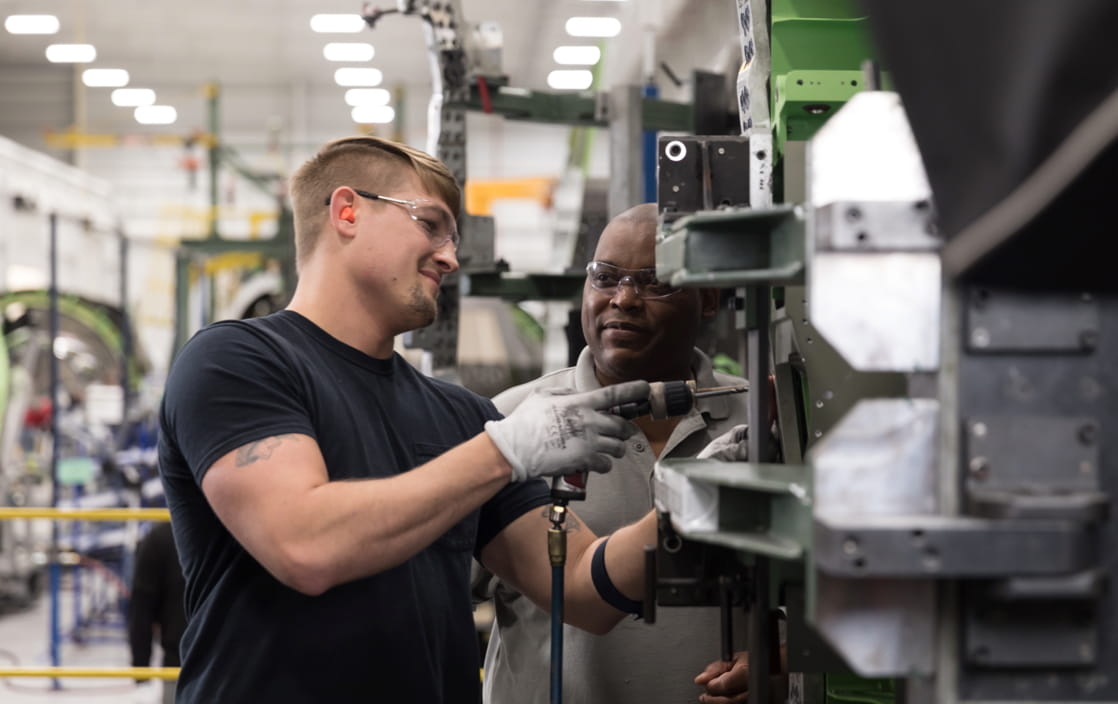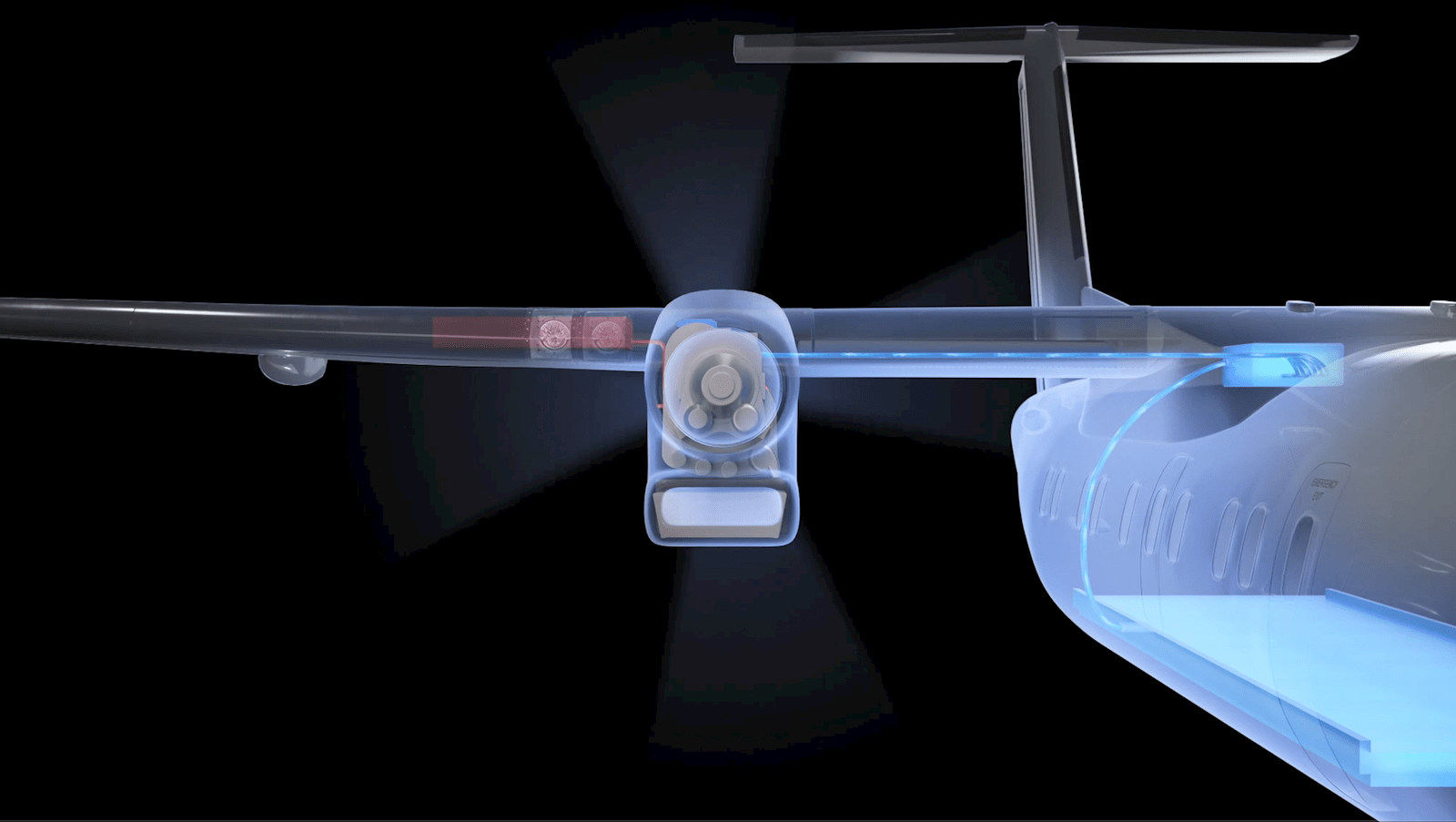The disruptors
Four coming breakthroughs that will change technology
Scientists and engineers are forging ahead on innovations that could bring a lot of change.
Raytheon Technologies is developing some of those technologies. Here are several that our experts are working on:
Air taxis
The aerospace industry is looking to adopt hybrid-electric engines for planes, bringing some of the same fuel efficiencies that are evident in cars. Going hybrid would make short, fast regional flights cheaper and more fuel efficient. Eventually, it could result in air taxis: small, nimble aircraft that shuttle people around like a rideshare.
One idea is to re-engine one side of a turboprop plane, replacing it with a hybrid of a one-megawatt engine and a one-megawatt electric motor. Each would provide half the power needed for takeoff, then the motor would throttle back, and the engine would take over for cruising and descent.
The result: a plane that uses 30% less fuel, and a bridge to new aircraft designs for vertical landing and takeoff — a key capability when it comes to flying around cities.
If that sounds a little like helicopters, it should — with one key difference: electrical propulsion. Efforts to use helicopters as everyday air ferries fall short because choppers are too noisy and too costly to operate at scale, said Waseem Naqvi, a Raytheon Technologies expert in military and civil unmanned aerial systems.
Electric air taxis "are going to be quieter and have many more rotors," he said. "They're going to start off small, with a pilot, but after they've been proven, in 10 years' timeframe, they'll move to an autonomous mode."
Smart cities
Every big city wants to be smart, using data to ease congestion, consume less energy, improve public safety and solve all kinds of quality-of-life problems.
The trouble is that the data is messy. It’s always changing. And there’s a ton of it. Using stats to optimize a city’s operations minute by minute is too complicated for even the most powerful computers.
Which is one reason why engineers are working on a new kind of computer altogether.
Quantum computing processes data in a way that lends itself to big, complex, dynamic problems. The key is a phenomenon called superposition, which allows quantum processors to see data as a combination of the two binary states (0 and 1, or “on” and “off”) that form the foundation of classical computing. With superposition, quantum computers can perform multiple tasks at the same time. While that won’t make it faster for every kind of computation, it does give quantum an edge in especially complicated problems — say, the calculations required to run a smart city.
And there’s much more within quantum’s realm, said Zac Dutton, who leads quantum information research at Raytheon Technologies.
“Whether you’re in the intelligence community with satellites, or the DoD with radars; whether you’re working in commercial sales, or big-data mining of some kind, everybody is trying to solve these problems and come up with the most efficient way to deploy their resources,” Dutton said. “Those are exactly the problems quantum computing can solve most quickly.”
Quantum computers, which also hold promise for areas like pharmaceutical engineering, encryption and analysis of low-resolution imagery, are still about five years from being practical, Dutton estimated. The big obstacle is that quantum computers are error-prone by nature; even a slight vibration or change in temperature can scuttle their calculations.
The quest to correct those errors has been under way for decades, but Dutton believes the answer is within reach — and that it will have been worth the wait.
“Quantum mechanics, to our knowledge, is the ultimate law of the physical universe. If you fully understand that and you implement a processing machine that fully utilizes quantum properties,” he said, “you have the most powerful machine possible.”
Always-comfortable clothing
Nanomaterials science could lead to clothing that keeps you warm when it’s cold but cool when you get warm.
It’s the same area of study that gave us such practical innovations as scratch-resistant lenses, antimicrobial toothbrushes and lightweight alloys for cars, planes and spaceships. And there’s so much more it can do — including many things inspired by nature itself — said Mary Herndon, an engineering fellow at Raytheon Technologies.
“Look to the natural world, the lotus leaf. That’s used in nano. You have this organic thing that grows, and it naturally wants to repel water,” she said. “Replicating these structures in the nanoscale allows us to control how surfaces respond to moisture. Those are the kinds of things we’re learning to incorporate and engineer in our products.”
Here's the crux of nanomaterials science: It turns out the world gave us a much wider variety of resources than we thought. To find them, scientists are looking at familiar materials — steel, silver and so on — in the nanoscale, with measurements in billionths of meters. At that scale, atoms and molecules interact differently, meaning nanoscale materials have different properties than they do in bulk.
And those properties can vary. Change the size of the particle and you tweak the effect. You can make silver melt at lower temperatures while keeping its conductivity. This opens the door to smaller and more flexible circuit cards, which in turn leads to embedded electronics, which in turn leads to all kinds of things — including clothes that can sense your skin temperature to ventilate when you’re warm and trap body heat when you’re cold.
“I guess that’s why all the futuristic shows have us wearing just one uniform,” Herndon said.
Computing, uncluttered
For years, corporate IT security policies have prompted workers to use both personal phones, tablets and desktop computers and work-only devices — a practice that helps keep company networks clear of unauthorized electronics.
But a different approach — one that never implicitly trusts any device, and knows exactly what each user is allowed to do — could change all that. Cybersecurity experts at Raytheon Technologies are working to apply the concepts of “zero trust” and “least privilege” — traditionally used only in segments of a company’s IT infrastructure — to every device on a network.
“With zero trust, if you’re not trusting any device, you can basically allow any device because you control at a granular level the things your user can do,” said Dylan Owen, senior manager of cyber protection services at Raytheon Technologies. “The key is interoperability — how to get networks, applications and operating systems all talking to each other to know that User X is authorized to access that resource.”
The network would require devices to authenticate every time its users open an email app or sign on to a cloud server. Then it would check that action against a list of things the user is authorized to do. That means even if an attacker steals an employee’s credentials, they’d be useless for any task outside that person’s normal responsibilities.
“You’ve mitigated an attack to some degree thanks to those permissions,” Owen said.
The approach could ease concerns for companies leery of cloud services and data centers, and it could simplify security for companies with workforces around the globe.
“If we see a device is logging in from Italy, there’s certain things they can’t get to,” such as information not allowed outside its country of origin, Owen said. “It helps enable a mobile workforce much more than we do today.”



